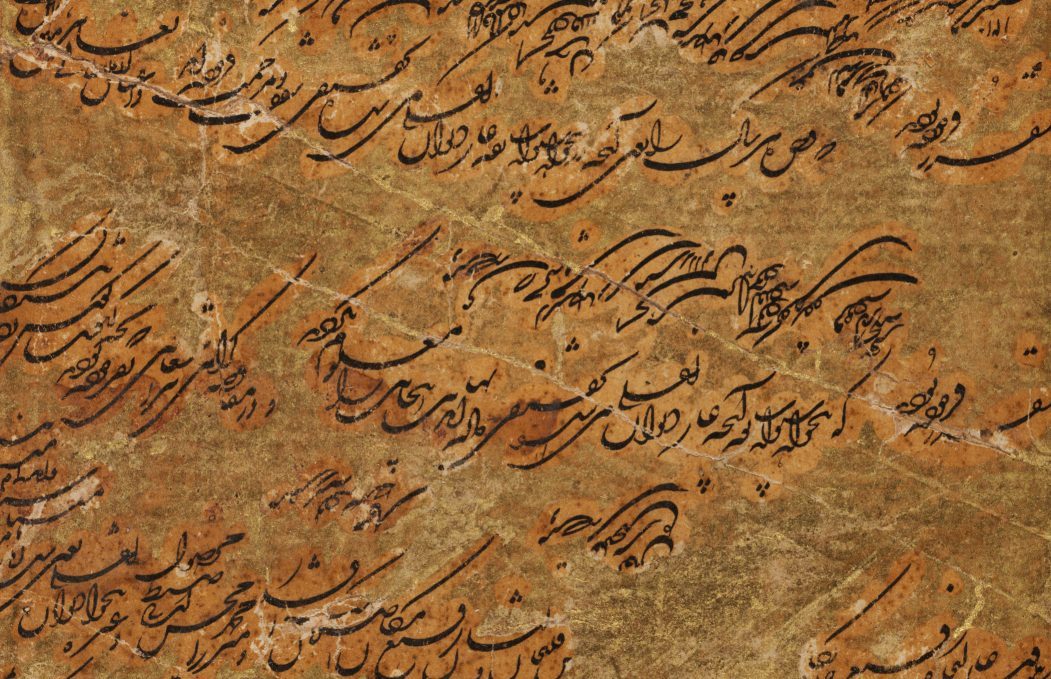
A DISPERSED ILKHANID NUZHAT-NAMA
The Ilkhanid period was marked by an extraordinary cultural vitality in which the arts flourished in a variety of ways that escape capture within a homogenous stylistic and formal framework. Among them, the arts of the book are particularly impressive both in terms of calligraphy, illumination and illustrations. This lecture will reflect on themes of Ilkhanid painting, focusing on a dispersed copy of the Nuzhat-nama-yi `Ala’i (`Ala’i’s Book of Pleasure) of Shamardan ibn Abi al-Khayr Razi datable to the turn of the 14th century, outstanding for its extraordinary paintings and calligraphic scripts.
PROF. ANNA CONTADINI
Anna Contadini is Professor of the History of Islamic Art at SOAS University of London. Her main areas of research are illustrated book culture of the Islamic world; object studies; translocation and transculturation; and artistic and cultural contacts between Europe and the Islamic world. She graduated in Arabic and Islamic Art at Venice University and obtained a Diploma in piano from the Conservatorio Benedetto Marcello. She then obtained a PhD in Islamic Art at SOAS, and was appointed Research Fellow in Islamic Studies at the V&A. She then took positions as Lecturer in Islamic Art at Trinity College and Curator of the Islamic Collections of the Chester Beatty Library, Dublin, before taking up a position at SOAS. Professor Contadini serves on numerous international Peer-Reviewing and Editorial, Scientific, and Advisory Boards. She has won several prizes and honours, including the Paris Collège de France medal for “the intellectual merits and world contribution to the history of art” in 2019.
She has held visiting professorships at Leiden, Heidelberg, and Bologna Universities, the Ecole des Hautes Études en Sciences Sociales in Paris, and Harvard University at I Tatti. Her latest publications are the results of long-standing projects, and include: “’The Work is Blessed, Unique’: The Fatimid Silver Casket of Sadaqa b. Yusuf”, in Bilotto, Gregory, Farhad Daftary and Shainool Jiwa (eds), Fatimid Cosmopolitanism. History, Material Culture, Politics and Religion, London: I.B. Tauris, 2025, pp. 335-371; Conoscenza e Libertà. Arte Islamica al Museo Civico Medievale di Bologna (bilingual), Genoa: Sagep Editori, 2024; “Intertextual Animals: Illustrated Kalila wa-Dimna Manuscripts in Context”, in Éloïse Brac de la Perrière et al. (eds), Les périples de Kalila et Dimna, Brill, 2022; The Pisa Griffin and the Mari-Cha Lion. Metalwork, Art, and Technology in the Medieval Islamicate Mediterranean (concept, author and editor), Pisa: Pacini Editore, 2018. She is the founder of the new Brill Monograph series Islamic Art in Resonance.
11 December 2025, 5 – 6.30 pm UK Time
Online Lecture on Zoom

THE SAFAVID MAJMŪ‘A AND JUNG MANUSCRIPTS
The manuscript collections across the world include many 16th and 17th centuries Persian book compilations (with terms and types such as majmū‘a, jung, Safīna, bayāż, and muraqqa‘). These books cover a broad range of genres, themes, and titles and compile them in several ways and through different methodologies which are yet to be studied. These genres, themes, and titles include poetry and prose, chancellery or personal epistles, treatise on arts, decrees, religious accounts and prayers, occult texts, poets’ biographies, tales and more.
This talk focusses on a few of such compilations, while considering them not only as containers of historical, literary, and artistic accounts, but more importantly, in many cases, as the carefully tailored, self-managing systems that operate efficiently through an inner logic of their constituent fragments. The talk is particularly concerned with discussing novel methodologies through which these compilations may be approached and analysed and how and under what mechanisms were these texts and images selected, assembled, and curated in such compilations.
DR MAHROO MOOSAVI
Mahroo Moosavi is an historian of early modern Iran and the broader Persianate world with a focus on the intertext of art and literature, especially on Safavid manuscript cultures and epigraphy. She is a Visiting Professor at the Institute for Cultural Studies, University of Düsseldorf. She has been a Postdoctoral Fellow at Max-Planck Institute, Kunsthistorisches Institut in Florenz, in collaboration with the Museum of Islamic Art, Pergamon Museum, Berlin. She held postdoctoral fellowships and visiting lectureships at University of Oxford and University of London.
In one of her ongoing projects, she critically examines the Safavid compilatory manuscripts (majmū‘a(s) and jung(s)), discussing potential methodologies through which this corpus may be approached, analysed, and studied. Her research on this subject has been supported by the British Academy, the British Institute of Persian Studies, University of Oxford, Warburg Institute, University of London, Max-Planck Institute, Kunsthistorisches Institut in Florenz amongst others.
20 November 2025, 5 – 6.30 pm UK Time
Online Lecture on Zoom
Now available: the recording on YouTube.
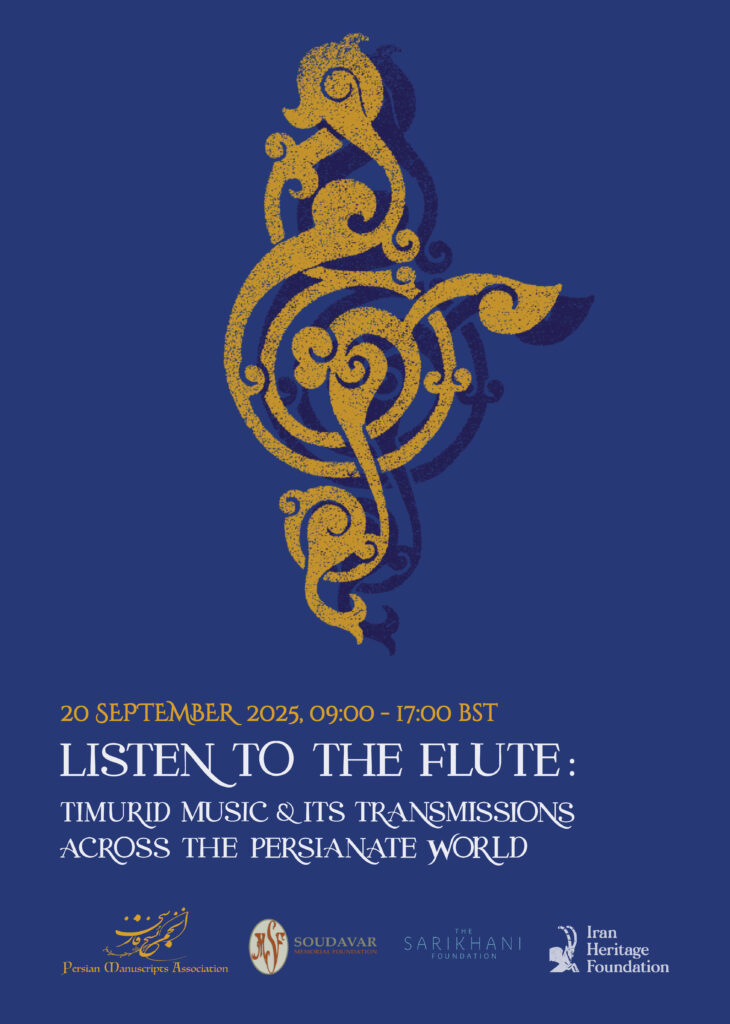
LISTEN TO THE FLUTE: TIMURID MUSIC AND ITS TRANSMISSIONS ACROSS THE PERSIANATE WORLD
The Persian Manuscripts Association (PMA) was pleased to hold its second international conference on Persian Studies, titled “Listen to the Flute: Timurid Music and its Transmissions Across the Persianate World.”
This interdisciplinary event focused on the intricate and complex history of musical exchange, patronage, and practice within the Persianate world, with a particular focus on the Timurid period (15th century) and its enduring influence during the following centuries in Safavid Iran, Ottoman Anatolia, Mughal India, and Shaybanid Transoxiana.
For the first time, this in-person and online conference convened leading scholars in the field to explore the historical, social, and political contexts that shaped musical practices across the Persianate world. It examined the evolution of music in the courts and urban centres of Iran, Central Asia, the Ottoman Empire, and Mughal India. Additionally, the conference explored the sociocultural impact of music, addressing its theoretical foundations, performance traditions, and the patronage systems that sustained and transformed the musical landscape.
In-Person and Online Conference
When: 20 September 2025
Where: Queen Mary Hall, The Coral Room
16-22 Great Russell Street London WC1B 3NN
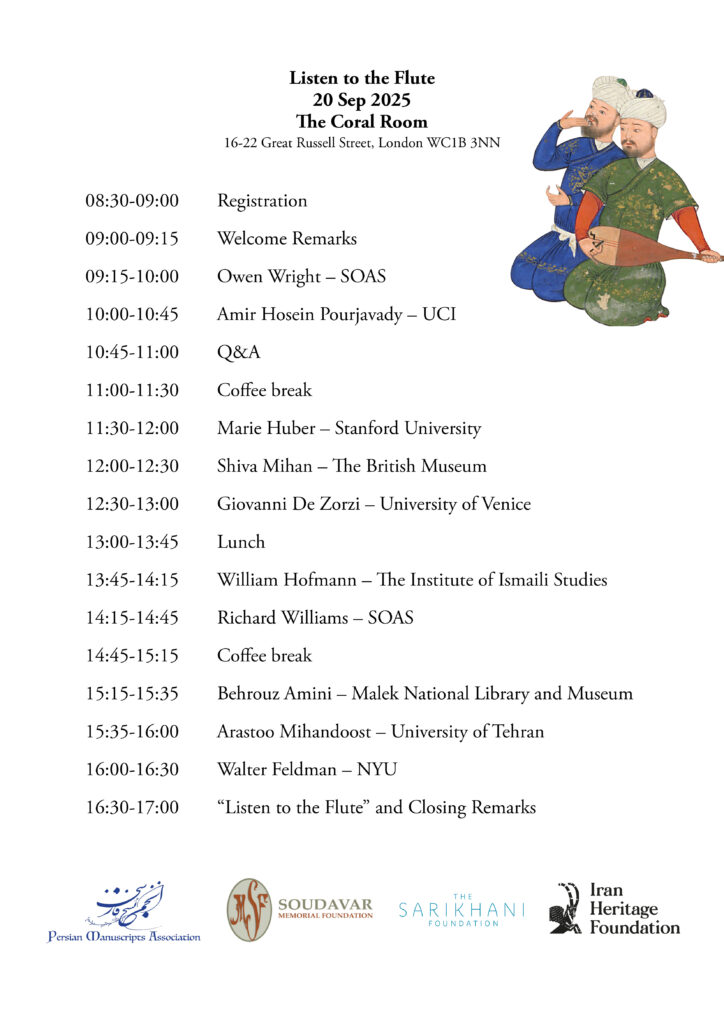

THE ADES COLLECTION OF CERAMICS AND ITS PROVENANCE
In 1949, Gurgan Faiences by Iranian curator Mehdi Bahrami was published in Cairo. In the work, Bahrami presents a group of 12th/13th-century ceramics which, he argues, were made and recently excavated in Gurgan, in Iran’s northeast. Many of the objects published were owned by Clement and Raymond Ades in Cairo. The V&A now holds 40 examples of these ceramics from Iran once owned by members of the Ades family, with many more in other British collections. Further objects published by Bahrami were owned by Jacques Matossian, an art and antiquities dealer also based in Cairo. In this talk, Fuchsia Hart will focus on the little-known figure of Matossian and his wider role in the lives of the ‘Gurgan faiences’ and the formation of the Ades Collection. While Bahrami’s publication provided a starting point for this research, Fuchsia will draw on documentation still held in the V&A archives to explore the collection histories of the Ades objects. Using additional archival material, the objects will also be contextualised within the wider market for art from Iran in 20th-century Egypt. While many questions remain about the provenance of the Ades Collection and the larger proposed group of ‘Gurgan faiences’, this talk will begin to explore the story of their journey from Iran to England, via Egypt.
DR FUCHSIA HART
Fuchsia Hart is a historian of the arts of the Islamic world, specialising in the arts of Iran. She has been the Sarikhani Curator for the Iranian Collection at the Victoria and Albert Museum in London since 2022. She is currently working on a number of projects, including a display of royal dress from Saudi Arabia and an article about British ceramics at the Qajar court. She holds a PhD in Asian and Middle Eastern Studies from the University of Oxford. Her PhD thesis explored the patronage of major shrines in Iran and Iraq by the second Qajar ruler of Iran, Fath ‘Ali Shah (r.1797-1834). In the past, she has held positions at the Bodleian Library (Oxford), the University of Warwick (UK), and Turquoise Mountain (Kabul).
24 July 2025, 5 – 6.30 pm UK Time
Online Lecture on Zoom
Now available: the recording on YouTube.
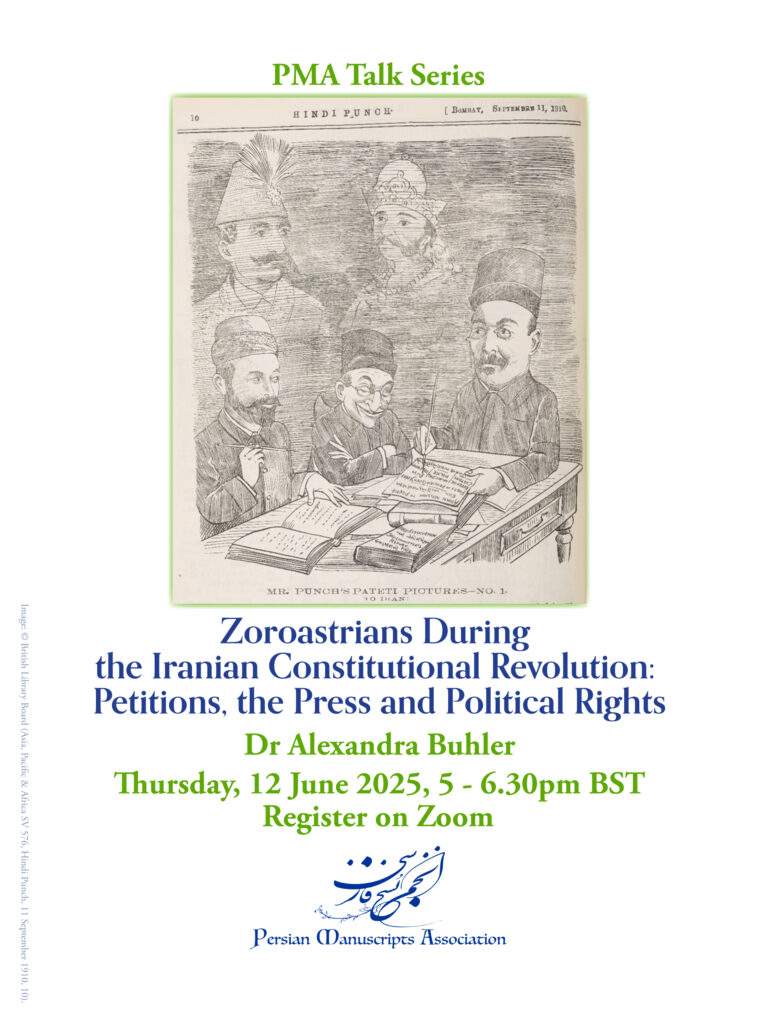
ZOROASTRIANS DURING THE IRANIAN CONSTITUTIONAL REVOLUTION: PETITIONS, THE PRESS AND POLITICAL RIGHTS
During the nineteenth century, Zoroastrians successfully made use of petitions to improve the position of their community in Iran, most notably in relation to the abolition of the jezya tax.
Drawing on research from her recent book, Alexandra Buhler will examine how the written word continued to be used in campaigns to secure greater rights and justice for Zoroastrians during the Iranian Constitutional Revolution (1906-1911).
Additionally, she will discuss how newspapers in Iran promoted positive attitudes towards Zoroastrians and raised awareness of the potential benefits of good relations with the Parsis, the influential Zoroastrian community of India. With the changing political situation in Iran, newspapers in India were also used as a medium to encourage Parsis to feel more connected to their ‘ancient homeland’.
Dr Alexandra Buhler
After studying Theology at Oxford University, Alexandra Buhler completed her MA and PhD at SOAS, where she also taught courses about Zoroastrianism and Iranian history. Her PhD focused on the involvement of Zoroastrians in the Iranian Constitutional Revolution, and the impact that the revolution had on members of the community. Alexandra is the author of Zoroastrianism in India and Iran: Persians, Parsis and the Flowering of Political Identity. (IB Tauris, 2024). She currently works in Libraries and Collections at King’s College London.
12 June 2025, 5 – 6.30 pm UK Time
Online Lecture on Zoom
Now available: the recording on YouTube.
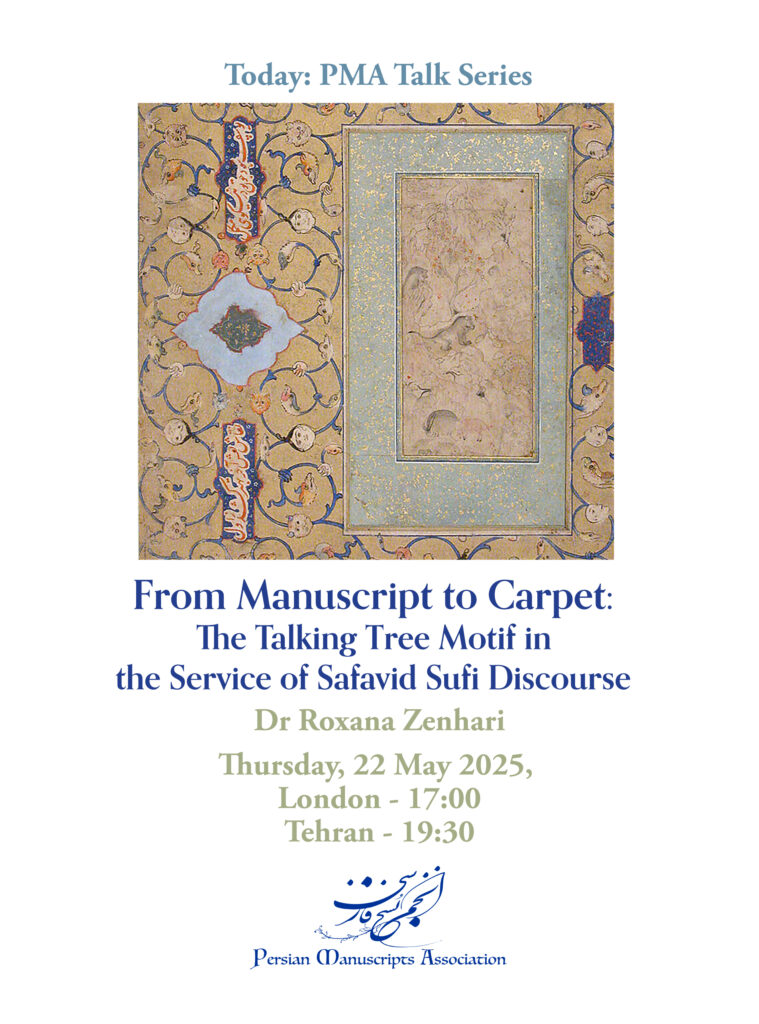
FROM MANUSCRIPT TO CARPET: THE TALKING TREE MOTIF IN THE SERVICE OF SAFAVID SUFI DISCOURSE
The presentation will highlight the formal and conceptual interrelations among two inscribed grave rugs (preserved in Lisbon, Gulbenkian Museum, Inv. T113; and Cincinnati, Cincinnati Art Museum, Inv. 1953.24); three dispersed illuminated folios of Jāmī’s Yusuf va Zuleykhā and Sa’dī’s Būstān (introduced by Christie’s, 2012 Live Auction 6537; and 2010 Live Auction 7871); and an illustrated manuscript of Niẓāmī’s Khamseh (Hazine 788), all attributed to Safavid workshops. Central to this exploration is the motif of the Talking Tree, which emerges as a dominant visual element across these works.
The discussion will focus on how this decorative motif, the literature, and the woven words interact, and how the motif evolves into a symbol that serves the Sufi discourse within the Safavid Shi’i context.
Dr Roxana Zenhari
Dr Roxana Zenhari is a historian of Islamic art, specialising in Persian visual art with a focus on manuscript culture. Her research explores the interrelation of text and image, and their connection to the dominant cultural and political discourses of the era.
She has published her dissertation and numbers of articles on Inju manuscripts, including Samak-e Ayyar (2014) and Inju Shahnameh manuscripts (2018,2020), and continues her research on the transition from manuscript culture to lithographed books.
She completed her Ph.D. in Iranian Studies at Georg-August University in 2012, where she is now affiliated as a lecturer.
22 May 2025, 5 – 6.30 pm UK Time
Online Lecture on Zoom
Now available: the recording on YouTube.

ARTISTIC INNOVATION AT THE LIBRARY OF PRINCE BAYSUNGHUR
Dr Shiva Mihan
Convenor: Professor Anna Contadini
ReSIA
(Research Seminar in Islamic Art)
Thursday 8 May 2025, 18:00h
Khalili Lecture Theatre – SOAS, University of London
Timurid prince Baysunghur (1397–1433) established his royal library and atelier (kitabkhana) in Herat circa 1420. In the brief but prolific period before his untimely death, the library produced over thirty manuscripts and advanced the arts of the book. Under his patronage, significant advancements were made in calligraphy, illumination, textual editing, mise-en-page, and album making (muraqqaʿ).
This paper introduces the structure and ambitions of Baysunghur’s kitabkhana, offering a reassessment of the oft-cited project report, the Arzadasht, and drawing on extant manuscripts and primary sources. Special attention is given to the Jung-i Marathi (Book of Elegies), a hitherto overlooked source that sheds light on the intellectual and aesthetic ambitions of the Baysunghur’s atelier.
Dr Shiva Mihan is Curator of Islamic Collections (Persianate World) at the British Museum. She received her PhD from the University of Cambridge in 2018, where her dissertation Timurid Manuscript Production: The Scholarship and Aesthetics of Prince Baysunghur’s Royal Library (1420–1435) was awarded the Leigh Douglas Memorial Prize by the British Society for Middle Eastern Studies in 2019. She has held curatorial and academic positions at leading institutions, including a postdoctoral fellowship as Curator of Islamic Art at the Harvard Art Museums (2018–2020) and a subsequent fellowship in Islamic Art at the School of Historical Studies, Institute for Advanced Study, Princeton. She has also taught Islamic art as a visiting professor at Washington University in St Louis. Mihan’s research centres on the history of Islamic manuscript production, artistic patronage, and the transmission of texts in the Persianate world. She is currently also the founder and President of the Persian Manuscripts Association. Her forthcoming monograph, Patronage and Manuscript Production in Timurid Herat, offers a new reading of manuscript culture under Prince Baysunghur. Bridging art history and intellectual history, the book explores the material and textual richness of manuscripts produced in Herat during the early 15th century, underscoring the often-overlooked significance of their literary content.


A REVIEW OF EARLY MANUSCRIPTS OF NASR ALLAH MUNSHI’S KALILA VA DIMNA
This presentation will focus on early manuscripts of the Persian version of Kalīla and Dimna—a book of (mostly) animal fables that is a classic of premodern world literature—by Naṣrallāh Munshī, written at the Ghaznavid court ca. 540/1145–46. Naṣrallāh’s text is considered one of the foundational works of classical Persian prose literature.
Among its noteworthy characteristics is that a few very early manuscript copies have survived, the oldest of which is dated 551/1156. In fact, although this Persian Kalīla and Dimna is based on the Arabic version attributed to Ibn al-Muqaffa‘ (ca. 750 CE), the very earliest extant copies of the Arabic are more recent, from the seventh/thirteenth century! The talk will discuss the curious phenomenon of the well-preserved codicology of Naṣrallāh Munshī’s work, showing example pages from three or four early manuscripts (as time permits).
Unsurprisingly, these Persian manuscripts from the sixth/twelfth and seventh/thirteenth century have interesting features of their own, in terms of orthography, calligraphic style, text layout, and more.
Dr Theodore Beers
Theodore Beers (PhD, University of Chicago, 2020) is a historian of classical Persian literature, with particular interests in premodern literary exchange between Persian and Arabic, and in the development of digital corpora and tools to strengthen the study of these traditions. He is currently based at Drexel University in Philadelphia as a research software engineer, and he also maintains an affiliation with the Kalīla and Dimna Project at the Freie Universität Berlin.
17 April 2025, 5 – 7 pm BST
Online Lecture on Zoom
Now available: the recording on YouTube.

PERSIAN MANUSCRIPT CATALOGUES IN CAMBRIDGE, A DOOR INTO DIGITAL HUMANITIES
The talk explores the use of computational methods for manuscript descriptions. It begins with an overview of Cambridge’s Persian manuscript collection in the context of UK collections. The speaker discusses how enhancing access to these collections motivated the use of computational techniques on descriptive data. A case study using data from the FIHRIST Union Catalogue of Islamicate Manuscripts is presented. The talk concludes by emphasising the significance of open access, standards, and data provenance in such research.
Yasmin Faghihi
Yasmin Faghihi is Head of the Near and Middle Eastern Department at Cambridge University Library. She is the editor of FIHRIST, the online union catalogue for manuscripts from the Islamicate world and chairs the Board of Directors. She has been leading on using and promoting standardised practices in text encoding for manuscript description and teaching to foster awareness about compatible approaches to data creation and use. Her work with the Middle Eastern and African manuscript collections has evolved around Islamic codicology including paper-making and distribution and the history of collections and collecting. Her Digital Humanities interests focus on the exchange of knowledge both as a historical and contemporary phenomenon, and how DH methodologies can impact the recognition of cultural diversity and offer new approaches to analysing cross-disciplinary frameworks.
13 March 2025, 5 – 7 pm
Online Lecture on Zoom
Now available: the recording on YouTube.
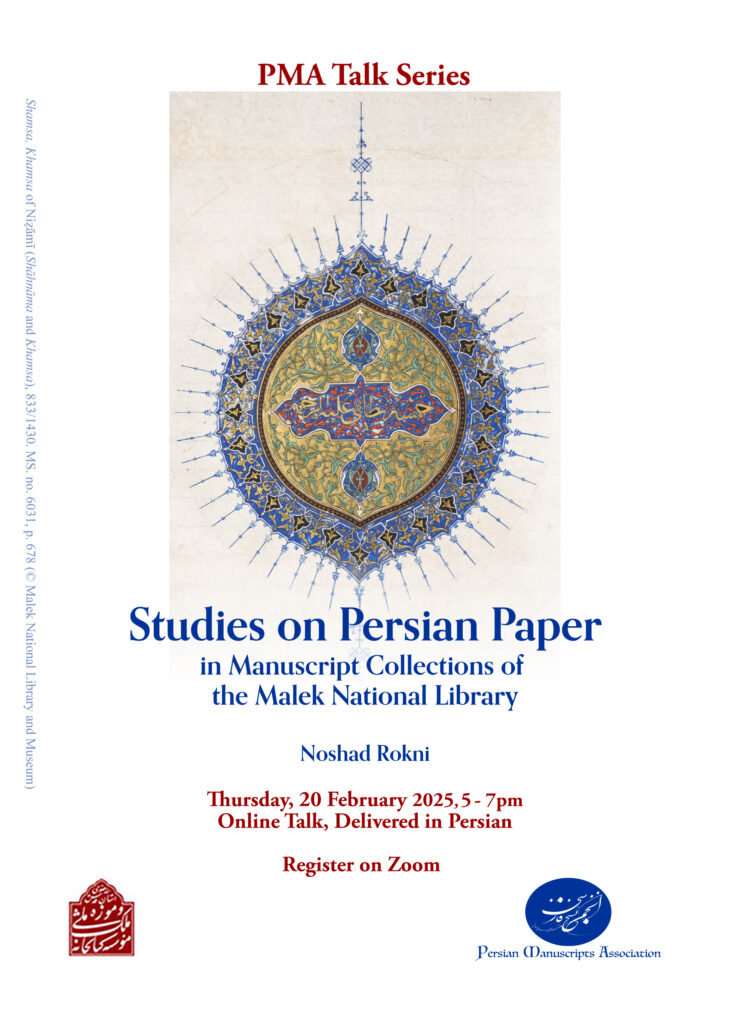
STUDIES ON PERSIAN PAPER IN MANUSCRIPT COLLECTIONS OF THE MALEK NATIONAL LIBRARY
This lecture, which will be delivered in Persian, focuses on the study of Persian paper used in the manuscript collections of the Malek National Library.
The talk will be presented by Noshad Rokni, head of the Library Department at the Malek National Library and Museum since 2024.
Noshad Rokni
Noshad Rokni is a distinguished expert in manuscript preservation, codicology, and Persian paper studies. Currently serving as the Head of the Library Department at the Malek National Library and Museum since 2024, he previously led the Cultural Information and Technical Preservation Department at the same institution for over a decade. Holding a Master’s degree in Restoration and Iranian Studies with a specialisation in Codicology, Rokni has dedicated his career to the study and preservation of historical manuscripts. As an instructor, he has contributed to multiple courses on codicology, paper studies, museology, and manuscript preservation. He has written over twenty publications on manuscripts and restoration.
20 February 2025, 5 – 7 pm GMT
Online Talk on Zoom
The talk will be delivered in Persian.
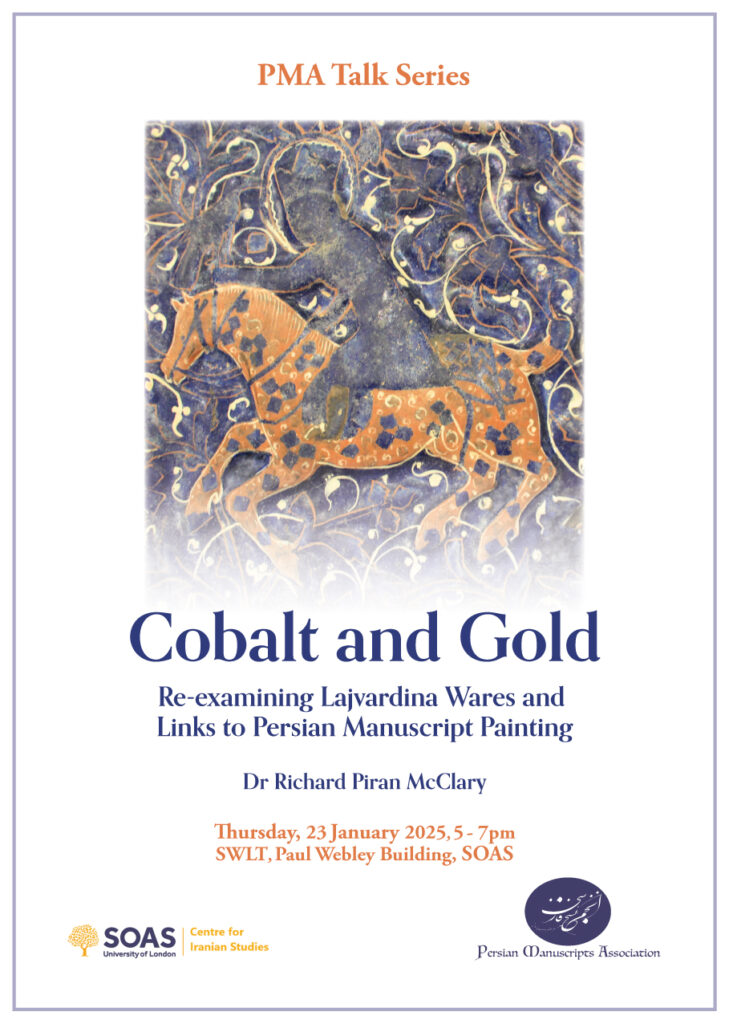
COBALT AND GOLD: RE-EXAMINING LAJVARDINA WARES AND LINKS TO PERSIAN MANUSCRIPT PAINTING
This lecture draws on some of the key themes explored in my recently completed monograph on lajvardina wares. There are significantly more tiles than vessels, and they have been subject to far less restoration an overpainting in most cases and will be the main focus. Striking as the tiles are, they are almost all decontextualised. By looking at some of the motifs seen not only on other tiles, but also on lajvardina vessels and other types of glazed ceramics, as well as other media, it can be possible to get a clearer idea of how lajvardina wares fit into the wider Ilkhanid aesthetic. In addition, a series of manuscript paintings will be examined in order to understand how the tiles may have appeared in their original architectural context, and to investigate if the ceramics and manuscripts can be used to better understand both media.
Dr Richard Piran McClary
Dr Richard Piran McClary is a Senior Lecturer in Islamic Art and Architecture at the University of York. He received his doctorate from the University of Edinburgh in 2015. He has lectured extensively on a range of subjects related to medieval Islamic art and architecture, and has conducted fieldwork in India, Iran, Turkey, Central Asia and across the Middle East. He has published three monographs with EUP; Rum Seljuq Architecture 1170-1220. The Patronage of Sultans (2017) and Medieval Monuments of Central Asia. Qarakhanid Architecture of the 11th and 12th Centuries (2020), and Mina’i Ware: A Reassessment and Comprehensive Study of Iranian Polychrome Overglaze Wares through Sherds (2024). He has published articles in numerous journals, including: Muqarnas, Iran, and the Journal of the Royal Asiatic Society. He has served as a trustee and the Research Director for the British Institute of Persian Studies, and is managing editor of the Journal of Islamic Art and Architecture.
23 January 2025, 5 – 7 pm GMT
SWLT, Paul Webley Building, SOAS University of London
In-person and Online
Now available: the recording on YouTube.
For More Information:
